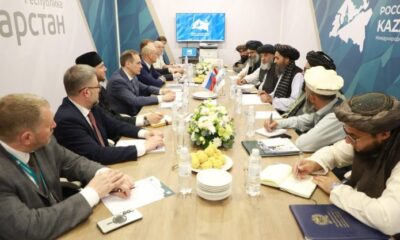Asia
Afghanistan-Iran and its water rights
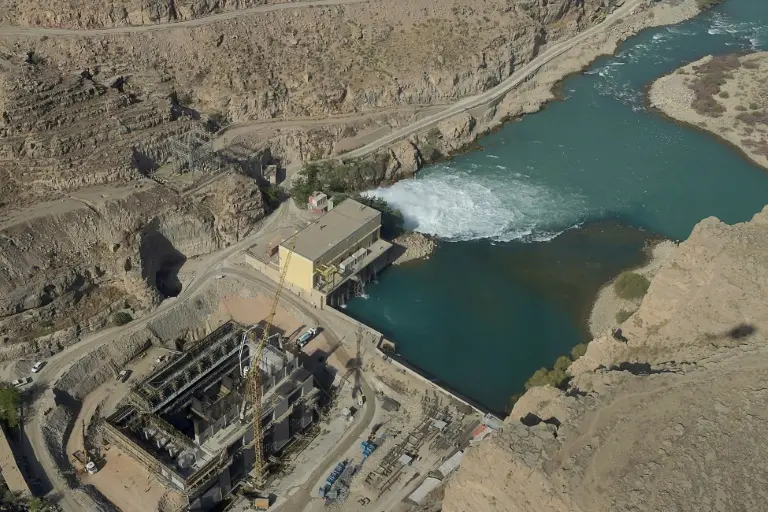
A dam near completion on the Helmand River in Afghanistan has become the center of disagreement between Afghanistan and Iran as both the neighbors’ dispute over water rights.
Afghanistan is considered as a self-sufficient water country but the irregularity and lack of structure has made it one of the lowest levels of water storage capacity in the world. There is estimation of at least 75 billion cubic meters (BCM) of water annually, where much of it is coming from big river basins such as the Amu, Helmand, Harirud-Murghab and Kabul. Mainly, these waters flow to the neighboring countries including Iran, Pakistan, Uzbekistan and Turkmenistan.
Afghanistan has failed to bring its water under control in the last 20 years or at least make a good deal with its neighbor over it. There was some “water strategy” on the paper to regularize the inflow of water, but apparently it was in vain. This came when the Afghan farmers moved to the urban centers to secure their livelihoods due to lack of water irrigation and insufficient water that badly affected their agricultural output.
At the same time, Afghanistan becomes an electricity-importer state while some of its water from major rivers, including Helmand River, flows to the neighboring countries. Afghanistan had decided to supervise these waters and tried to build dams to generate electricity.
In that purpose, the Afghan government has started to invest in construction of new dams in the Helmand River, a tributary considered the lifeline of water in Afghanistan, and its basin covers approximately 49pc of the surface area of the country.
But apparently Iran is not happy with the process and after failing to reach any consensus on the area of diplomacy, now it has tried to threaten the Afghan government to reopen the flow of water.
Iran warns Afghanistan over water rights
Iran’s President Ebrahim Raisi has openly called on the Afghan leaders not to violate water rights of the Iranian people and said his government is determined to defend this right.
Raisi warned the Taliban not to violate water rights of the people of Sistan and Baluchistan over their shared Helmand River, and called on the Taliban to take his world “seriously”.
Raisi also said that the Taliban should allow Iranian hydrologists to check the water levels of the river.
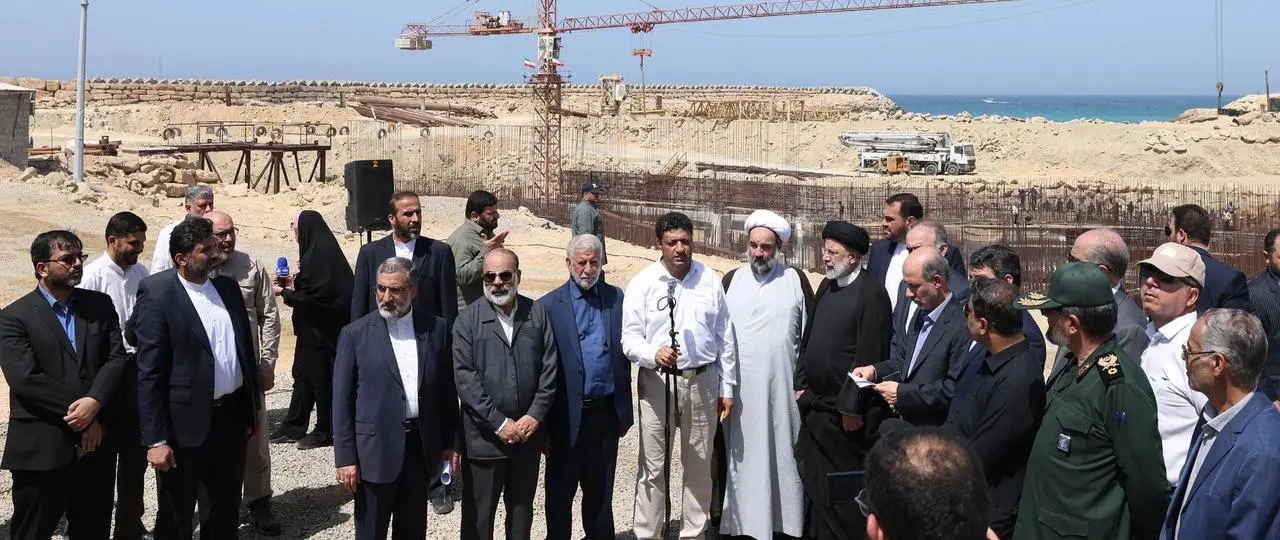
President Ebrahim Raisi during the inauguration ceremony of a project to supply water from the Gulf of Oman Iran’s eastern cities on May 18, 2023.
This is not the stop point as his Foreign Minister Hossein Amirabdollahian also came up with the same warning and said Iran will use “pressure as a tool,” to make the Taliban agree to allow its water from the Helmand River to flow inside Iran.
Amirabdollahian raised the water issue during his trip to southeastern border provinces of Sistan and Baluchestan, where he is scheduled to follow up on the case of Iran’s water rights, which has not become a center of a dispute with its neighbor Afghanistan.
Based on the 1973 treaty between Iran and Afghanistan, Amirabdollahian said that the people of Iran’s Sistan and Baluchestan have “a natural right” to benefit from the water that flows into the country from Afghanistan.
Meanwhile, the Iranian Space Agency said satellite images showed that the Afghan government prevented water from reaching the Iranian side of the border in some places by creating numerous dams and diverting the flow of water.
The agency said it was ready to submit the images, captured by the Iranian-made Khayyam satellite, to the Foreign Ministry.
Afghan-Iran FMs spoke on phone
Meanwhile, Afghanistan’s acting foreign minister, Mawlavi Amir Khan Muttaqi held a telephonic conversation with Iranian counterpart Amirabdullahian, where the two sides discussed the expansion of cooperation in different sectors including trade, electricity, railway, common border, water and release of Afghan prisoners in Iran.
During the talk, Muttaqi expressed his satisfaction with the recent visit of the Afghanistan trade delegation headed by the country’s minister of commerce and industry to Iran, and stressed that the two sides should intensify work to implement the Khaf-Herat railway project.
However, Muttaqi said that due to a drop in rainfall in the western parts of Afghanistan, the country has seen a significant drop in the amount of water in the Helmand River.
Taliban Spokesman Zabihullah Mujahid also said that due to severe drought, the water levels have dropped but said Kabul is “committed” to fulfill its obligation in the water treaty.
Inappropriate statements harm ties
At the same time, Mujahid warned Iran over “inappropriate statements”, saying such behavior could harm ties between the two countries and should not be repeated.
Iranian officials have always stressed the importance of the implementation of the 1973 Helmand River treaty between Iran and Afghanistan, but Kabul says that drought and climate change has significantly reduced the level of water. At the same time Iran has been suffering from drought for some 30 years, but has worsened over the past decade, according to the U.N.’s Food and Agriculture Organization. The Iran Meteorological Organization says that an estimated 97pc of the country now faces some level of drought.

Taliban Spokesman Zabiullah Mujahid said the Islamic Emirate is committed to the water treaty of Helmand signed in 1973 between Afghanistan and Iran.
To overcome the drought, Iran has called on the Taliban to open the gates of the Kajaki,” a major hydroelectric power dam in Afghanistan on the river’s path.
However, the dam has been dried up due to severe drought, but the Iranian authorities doubt Taliban’s statement and say they need to go and see from near.
“Until Iran’s technical experts are not allowed to visit the water flow and upstream of Hirmand according to the Hirmand Treaty, especially Article 5 of Protocol No. 1 of that treaty, any comments regarding the reduction in Hirmand water are not acceptable,” Iranian media Mehr reporting citing the country’s foreign ministry’s statement.
Diverting the river’s water flow and non-cooperation on the part of Afghan officials cannot be justified by making political statements, the statement reads.
Still friendly negotiations on table
Iran said that so far negotiations and talks have been held in a friendly atmosphere and by adhering to the principle of good neighborliness, and expects that such talks should continue to resolve any kind of issues as other options are also on the table.
The statement furthered that Iran has the right to use other options and reserves to take necessary actions to defend from its water interest, but called on Afghanistan to fulfill its responsibility based on the agreement.
Responding to the statement, Taliban said that the water agreement between Afghanistan and Iran was signed half a century ago in 1973 and is still valid.
“The Islamic Emirate is committed to implementing its obligations,” Taliban foreign ministry said in a statement, and accused the Iranian side of lacking information on current water level and circumstances in the region.
Taliban said that Iranian officials should first complete their information about Helmand water and then express their demand with appropriate words.
Taliban once again retreated that “inappropriate” statements can harm the political relations between the two neighboring countries which is not in the interest of each side.
Asia
Chinese navy chief and top nuclear scientist expelled from legislature

The chief of staff for the People’s Liberation Army (PLA) Navy, Vice Admiral Li Hanjun, and Liu Shipeng, the deputy chief engineer of the state-owned China National Nuclear Corporation, were removed from their positions in the country’s legislative body.
Li is the latest in a series of PLA generals and a handful of defense industry executives implicated in a widespread investigation within the military.
In a statement on Friday, the NPC Standing Committee announced, “The Navy Soldiers’ Congress has decided to remove Li Hanjun from his post as a representative to the 14th National People’s Congress.”
The Gansu People’s Congress also dismissed Liu Shipeng from his role as an NPC deputy.
Additionally, the Standing Committee revealed it had voted to remove Miao Hua, a former top general who previously oversaw the PLA’s ideological work, from the Central Military Commission (CMC), China’s highest military command body led by President Xi Jinping.
The removal of Li and Liu from their NPC memberships suggests they are facing serious disciplinary action.
China typically remains silent about purges within the military, and announcements from the NPC are one of the few indicators of such campaigns.
There is little public information available about Li and Liu, as both have worked in sensitive positions.
Before becoming the navy’s chief of staff, Li, 60, was the deputy director of the CMC’s Training and Administration Department. He was appointed to this role after serving for a year in the CMC’s Office for Reform and Organisational Structure.
In 2014, he was promoted to vice admiral upon his appointment as commander of the naval base in Fujian province, where Miao also spent a significant part of his career. At that time, he was the director of training at the China Naval Command College and was soon promoted to president of the school.
According to official media reports, nuclear scientist Liu was born into a family that “served China’s nuclear dream for three generations.”
As the deputy chief engineer at CNNC, which oversees all aspects of China’s civil and military nuclear programs, Liu also served as the Communist Party secretary and president of CNNC’s “404 base” in Gansu.
Covering an area of over 1,000 square kilometers, the base was established in 1958 and is the country’s first and largest nuclear research center. It played a crucial role in the development of China’s first atomic bomb in 1964 and its first hydrogen bomb three years later.
This secretive base is still considered a key hub for China’s nuclear deterrence and nuclear industry.
According to statements from provincial authorities, Liu was named “Gansu’s outstanding entrepreneur” in 2023.
Asia
China, US reach agreement on export controls

The Chinese Ministry of Commerce announced on Friday afternoon that Beijing and Washington have remained in close contact since the two-day trade talks in London earlier this month, confirming the details of a framework agreement.
“China will review and approve export applications for controlled items in accordance with its laws and regulations, and the US side will, in turn, lift a series of restrictive measures against China,” the ministry stated.
“We hope the US side will cooperate with China in line with the important consensus and conditions established during the conversation between the two presidents on June 5,” the statement continued.
On Thursday, US President Donald Trump said the US had “signed” a trade deal with China the previous day, without providing details.
“We signed the deal with China yesterday, right? We signed the deal with China,” Trump said at a White House event introducing a budget law. “With the China deal, we are starting to open up China,” he added.
He also mentioned that a “very big” deal, likely with India, would be signed soon.
Rare earth elements
Following the event, US Commerce Secretary Howard Lutnick told reporters that the US and China had signed an agreement codifying the terms decided upon in previous trade negotiations.
“They will deliver rare earth elements to us,” Lutnick said in a televised interview with Bloomberg, adding that if this commitment is fulfilled, Washington will lift its “countermeasures.”
Rare earth elements, essential for producing high-tech products, including those for the defense industry, were a major point of contention in the trade talks. China holds a near-monopoly on the supply of these minerals due to its massive share of global refining capacity.
Responding to a question on Thursday about rare earth exports, ministry spokesman He Yadong said China had approved a “certain number” of applications and would “continue to strengthen” the review and approval process for eligible applications.
He added that Beijing is willing to “strengthen communication and dialogue” with other countries on export controls and actively promote appropriate trade.
Lutnick also stated that the US plans to reach agreements with 10 major trading partners in the coming weeks. The deadline for countries to negotiate trade terms before higher tariffs are reinstated was July 9, following a 90-day suspension of import tariff hikes announced on April 2.
The two negotiating teams concluded the London talks by announcing they had agreed “in principle” on a “framework” that both sides would take home for their respective leaders to review, as they sought to get their uneasy truce, signed last month in Geneva, back on track.
The negotiations began after a highly anticipated phone call between Xi Jinping and Trump, which seemingly ended an intractable stalemate.
In the weeks following the initial agreement in Switzerland, Washington claimed China was restricting exports of critical minerals, while Beijing reacted to US restrictions on semiconductors and threats to impose visa barriers on Chinese students.
Asia
China hosts SCO defense ministers on warship amid regional tensions

Chinese Defense Minister Dong Jun hosted his Iranian counterpart and other high-level defense officials from Shanghai Cooperation Organisation (SCO) member states aboard an advanced Chinese warship, just days after the US bombed Iran’s nuclear facilities.
Iranian Defense Minister Aziz Nasirzadeh was among the defense officials welcomed by Dong on a military vessel in the coastal city of Qingdao, China, as part of a two-day SCO defense ministers’ meeting that concluded on Thursday.
According to Chinese state television CCTV, Nasirzadeh and other defense officials toured the People’s Liberation Army (PLA) Navy’s Type 052D destroyer, the Kaifeng, and later attended a reception on the ship’s deck.

Aboard the ship, Nasirzadeh thanked Beijing for “supporting Iran’s legitimate position following the recent attacks” by Israel and the US.
“We hope that China will continue to stand on the side of justice, help maintain the current ceasefire, and play a greater role in de-escalating regional tensions,” Nasirzadeh said, according to Xinhua.
In his address to the assembled ministers, Dong reportedly stated that “unilateralism, protectionism, and hegemonic and bullying acts are on the rise, seriously disrupting the international order and becoming the greatest source of chaos and conflict.”
Dong called for closer cooperation within the United Nations, the SCO, and other multilateral frameworks, urging members to unite with “more like-minded forces” to defend international justice and maintain global stability.
“SCO countries must remain true to the organization’s founding ideals, uphold the ‘Shanghai Spirit,’ and deepen practical cooperation in all areas,” Dong said. “With stronger actions, we can jointly safeguard a peaceful environment for development,” he added.
The event followed the US attacks on three of Iran’s key nuclear facilities on Saturday, which Beijing strongly condemned.
The Chinese Foreign Ministry stated that the attacks on nuclear facilities under the supervision of the International Atomic Energy Agency seriously violated the UN Charter and its principles.
Additionally, the SCO meeting coincided with a NATO leaders’ summit in The Hague. In a statement from The Hague, US President Donald Trump announced that the US would hold talks with Iran about a possible nuclear deal “in the coming week.”
Bilateral Talks
According to Xinhua, the Chinese defense minister later held separate bilateral meetings with the defense ministers of Belarus, Pakistan, Kyrgyzstan, and Russia. The state news agency reported that all parties appreciated Beijing’s efforts and significant contributions to developing SCO operational mechanisms and deepening inter-sectoral cooperation during its rotating presidency. They also expressed a strong will to further consolidate and expand military ties.
Pakistani Defense Minister Khawaja Asif praised Beijing’s role in de-escalating tensions. “Pakistan highly values its robust friendship with China and is ready to work together to implement its three global initiatives, deepen military cooperation, and help maintain regional peace and stability,” he said.
For Russian Defense Minister Andrei Belousov, this year—the 80th anniversary of the victory in World War II, the Chinese people’s war of resistance against Japanese aggression, and the world’s anti-fascist war—presents an opportunity to deepen bilateral military relations. “In line with the consensus of our leaders, we will intensify strategic communication and cooperation and contribute to global strategic stability,” he said.
Meanwhile, Indian Defense Minister Rajnath Singh also attended the Qingdao meeting. This marked the first visit by an Indian defense minister to China since the deadly border clash between the two countries in 2020.
Military trust
According to the Chinese Ministry of Defense, the SCO defense ministers’ meeting is one of the key events held during China’s rotating presidency of the SCO this year. The ministers, along with representatives from the SCO and regional anti-terrorism bodies, gathered to further strengthen military trust and deepen practical cooperation among member states.
The SCO, a 10-nation bloc comprising China, Russia, Kazakhstan, Kyrgyzstan, Tajikistan, Uzbekistan, Pakistan, India, Iran, and Belarus, currently covers approximately three-fifths of the Eurasian continent and about 43% of the world’s population.
The Beijing meeting, held under the rotating presidency of the Shanghai Cooperation Organisation, highlighted China’s role as a significant international actor and the importance Tehran places on its relationship with Beijing, even as China has largely remained on the sidelines of the Israel-Iran conflict.
During a regular press conference at the Chinese Ministry of Defense on Thursday, when asked if Beijing was considering providing military support to Iran as an SCO member, ministry spokesman Zhang Xiaogang told CNN, “China is ready to cooperate with all parties to play a constructive role in maintaining peace and stability in the Middle East.”
Kaifeng destroyer
The Kaifeng destroyer, where the meeting’s reception was held, is the sixth vessel of the extended Type 052D variant and serves in the North Sea Fleet. Commissioned in April 2021, the ship is approximately 159 meters (521 feet) long, weighs 7,500 tons, and is equipped with 517C anti-stealth radar. Its expanded deck allows for the landing of the PLA Navy’s Z-20 helicopters.
The warship has conducted numerous long-range exercises, including a passage through the Tsushima Strait in April, as part of Beijing’s growing operational presence in the western Pacific.
It was publicly displayed during the 74th-anniversary celebrations of the Chinese navy in Qingdao in 2023.
-
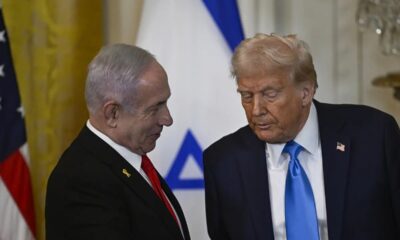
 Middle East1 week ago
Middle East1 week agoUS to launch major bombing campaign against Iran this weekend, Hersh reports
-
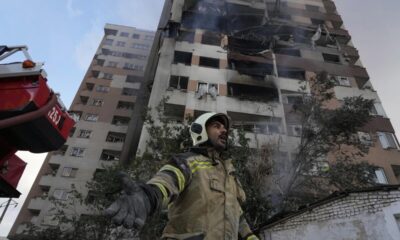
 Diplomacy2 weeks ago
Diplomacy2 weeks agoFormer diplomat warns forcing Iran out of the NPT is the greatest danger
-

 Middle East2 weeks ago
Middle East2 weeks agoIran targets Mossad and Unit 8200 in missile attack on Tel Aviv
-
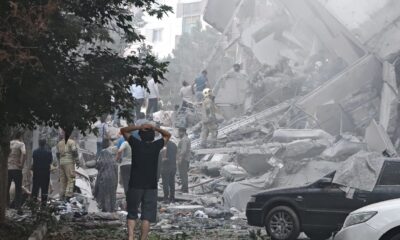
 Diplomacy2 weeks ago
Diplomacy2 weeks agoFormer CIA analyst says Israel used ceasefire talks as a trap
-

 Middle East2 weeks ago
Middle East2 weeks agoIranian missile attack causes heavy damage across Israel
-
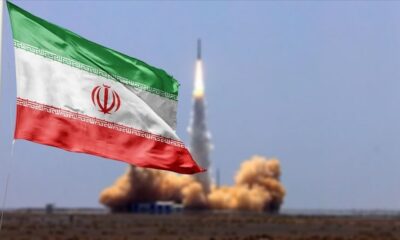
 Middle East2 weeks ago
Middle East2 weeks agoIran signals NPT withdrawal amid rising tensions with Israel
-

 Russia2 weeks ago
Russia2 weeks agoRussia alleges UK-Ukraine plot for false flag attack on US Navy in Baltic Sea
-

 Asia2 weeks ago
Asia2 weeks agoIran’s uranium enrichment program since 1979










